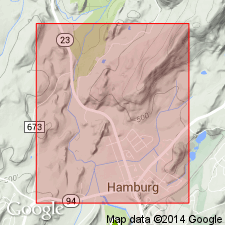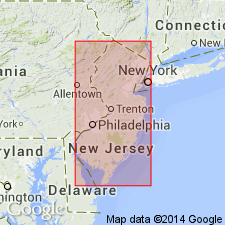
- Usage in publication:
-
- Big Springs Member
- Modifications:
-
- Named
- Dominant lithology:
-
- Dolomite
- Limestone
- AAPG geologic province:
-
- Appalachian basin
Summary:
Fine- to medium-grained gray dolomite and limestone with bands of siliceous shale and quartzite here named Big Springs Member of Epler Formation, probably for Big Spring, a spring on northwest side of NJ Rte 94, about 5 km southwest of Hamburg, Sussex Co. Weathers red to orange or pale blue. Thickness ranges from 12 to 46 m. Overlies Branchville Member; underlies Lafayette Member. Age is Early Ordovician.
Source: GNU records (USGS DDS-6; Reston GNULEX).

- Usage in publication:
-
- Big Springs Member
- Modifications:
-
- Overview
- AAPG geologic province:
-
- Appalachian basin
Summary:
Nomenclature in this report follows Markewicz and Dalton (1977) who divided the Epler Formation in NJ into (ascending) Branchville, Big Springs, and Lafayette Members. The Big Springs is 40 to 150 ft thick and consists of variable dolomite and limestone. Near Hamburg, unit consists of light- to medium-gray, fine- to medium-grained dolomite with local green to pink bands or lenses consisting of siliceous dolomite, quartzite, and/or siliceous shale. Unit contains cross-bedding, chip conglomerates, cut and fill, oolites, chert, and red and green argillitic dolomite. Weathered surface has a distinctive bright-red to yellow-orange rind. In the northern part of the outcrop area, occasional limestone lenses replace all or part of the member which weather to powder blue with green or red-brown siliceous interbeds. Age of the Epler is Early Ordovician.
Source: GNU records (USGS DDS-6; Reston GNULEX).
For more information, please contact Nancy Stamm, Geologic Names Committee Secretary.
Asterisk (*) indicates published by U.S. Geological Survey authors.
"No current usage" (†) implies that a name has been abandoned or has fallen into disuse. Former usage and, if known, replacement name given in parentheses ( ).
Slash (/) indicates name conflicts with nomenclatural guidelines (CSN, 1933; ACSN, 1961, 1970; NACSN, 1983, 2005, 2021). May be explained within brackets ([ ]).

